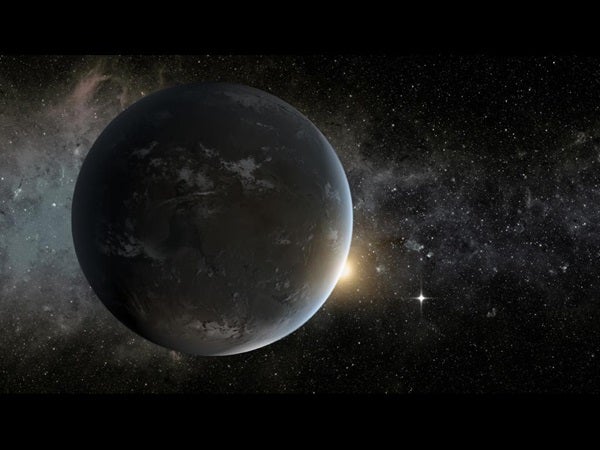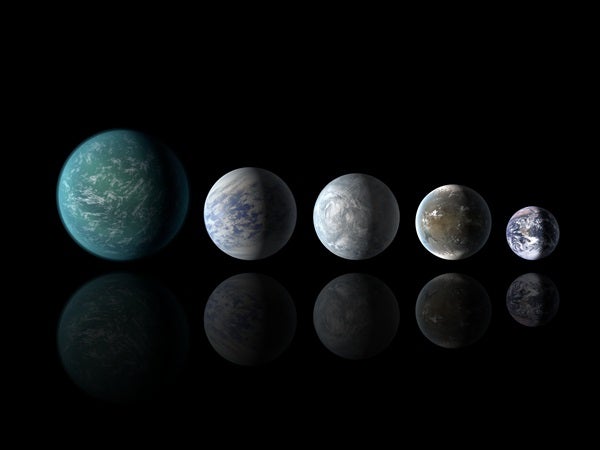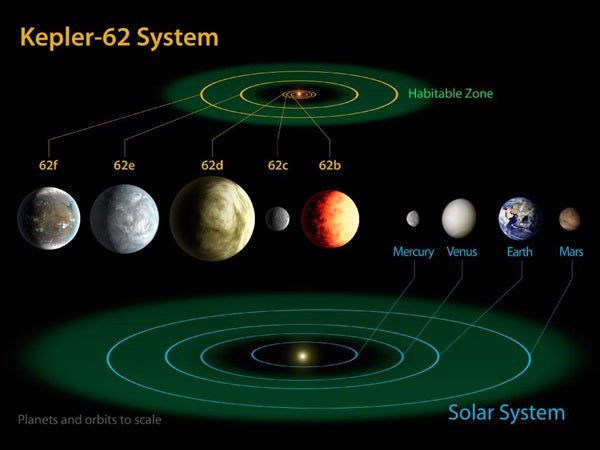The Kepler-62 system has five planets: 62b, 62c, 62d, 62e, and 62f. The Kepler-69 system has two planets: 69b and 69c. Kepler-62e, 62f, and 69c are the super-Earth-sized planets.
Two of the newly discovered planets orbit a star smaller and cooler than the Sun. Kepler-62f is only 40 percent larger than Earth, making it the exoplanet closest to the size of our planet known in the habitable zone of another star. Kepler-62f is likely to have a rocky composition. Kepler-62e orbits on the inner edge of the habitable zone and is roughly 60 percent larger than Earth.
The third planet, Kepler-69c, is 70 percent larger than Earth and orbits in the habitable zone of a star similar to our Sun. Astronomers are uncertain about the composition of Kepler-69c, but its orbit of 242 days around a Sun-like star resembles that of our neighboring planet Venus.
Scientists do not know whether life could exist on the newfound planets, but their discovery signals that astronomers are another step closer to finding a world similar to Earth around a star like our Sun.
The Kepler space telescope, which simultaneously and continuously measures the brightness of more than 150,000 stars, is NASA’s first mission capable of detecting Earth-sized planets around stars like our Sun.
Orbiting its star every 122 days, Kepler-62e was the first of these habitable zone planets identified. Kepler-62f, with an orbital period of 267 days, was later found by Eric Agol, associate professor of astronomy at the University of Washington.
The scientists have measure the size of Kepler-62f is now measured, but they have yet to determine its mass and composition. Based on previous studies of rocky exoplanets similar in size, however, astronomers are able to estimate its mass by association.
“The detection and confirmation of planets is an enormously collaborative effort of talent and resources, and requires expertise from across the scientific community to produce these tremendous results,” said William Borucki, Kepler science principal investigator at NASA’s Ames Research Center at Moffett Field, California. “Kepler has brought a resurgence of astronomical discoveries, and we are making excellent progress toward determining if planets like ours are the exception or the rule.”
The five planets of the Kepler-62 system orbit a star classified as a K2 dwarf, measuring just two-thirds the size of the Sun and only one-fifth as bright. At 7 billion years old, the star is somewhat older than the Sun. It is about 1,200 light-years from Earth in the constellation Lyra.
A companion to Kepler-69c, known as Kepler-69b, is more than twice the size of Earth and whizzes around its star every 13 days. The Kepler-69 planets’ host star belongs to the same class as our Sun, called G-type. It is 93 percent the size of the Sun and 80 percent as luminous; it’s located approximately 2,700 light-years from Earth in the constellation Cygnus.
“We only know of one star that hosts a planet with life — the Sun. Finding a planet in the habitable zone around a star like our Sun is a significant milestone toward finding truly Earth-like planets,” said Thomas Barclay, Kepler scientist at the Bay Area Environmental Research Institute in Sonoma, California, and lead author of the Kepler-69 system discovery.
When a planet candidate transits, or passes in front of, the star from the spacecraft’s vantage point, a percentage of light from the star is blocked. The resulting dip in the brightness of the starlight reveals the transiting planet’s size relative to its star. Using the transit method, Kepler has detected 2,740 candidates. Using various analysis techniques, ground telescopes and other space assets, astronomers have confirmed 122 as planets.
Early in the mission, the Kepler telescope primarily found large gas giants in very close orbits of their stars. Known as “hot Jupiters,” these worlds are easier to detect due to their size and very short orbital periods. Earth would take three years to accomplish the three transits required to be accepted as a planet candidate. As Kepler continues to observe, transit signals of habitable zone planets the size of Earth orbiting stars like the Sun will begin to emerge.












